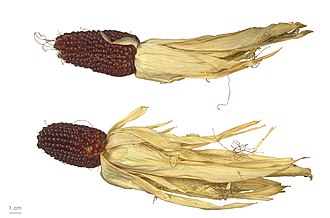Maize
Maize or Indian corn[1] (called corn in some countries) is Zea mays, a member of the grass family Poaceae. It is a cereal grain which was first grown by people in ancient Central America. Approximately 1 billion tonnes are harvested every year. However, little of this maize is eaten directly by humans. Most is used to make corn ethanol, animal feed and other maize products, such as corn starch and corn syrup.
| Maize | |
|---|---|

| |
| Cultivars of maize | |
| Scientific classification | |
| Kingdom: | Plantae |
| Order: | Poales |
| Family: | Poaceae |
| Genus: | Zea |
| Species: | Z. mays
|
| Binomial name | |
| Zea mays | |
Maize is a leafy stalk whose kernels have seeds inside. It is an angiosperm, which means that its seeds are enclosed inside a fruit or shell. It is has long been a staple food by many people in Mexico, Central and South America and parts of Africa. In Europe and the rest of North America, maize is grown mostly for use as animal feed. In Canada and the United States, maize is commonly referred to as "corn".
Centuries of cross breeding have produced larger plants, and specialized varieties. Corn has become an important ingredient in American foods through the use of corn starch. People have long eaten sweet corn and popcorn with little processing, and other kinds after processing into flour for making cornbread, tortillas, and other artificial foods.
Maize has been a fruitful model organism for research in genetics for many years: see Barbara McClintock. Research has shown that artificial selection developed maize from a Mexican plant called Teosinte.[2]
The genus Zea
There are five species and many subspecies in the genus. They are all plants similar to the cultivated maize, with less developed cobs. The wild ones are sometimes called teosintes, and they are all native to Mesoamerica.
Maize Media
Exotic varieties are collected to add genetic diversity when selectively breeding new domestic strains.
Ancient Mesoamerican relief sculpture of maize, National Museum of Anthropology of Mexico
Cultivation of maize, illustrated in the 16th-century Florentine Codex
Disease cycle of Northern corn leaf blight
Female inflorescence, with young silk
References
- ↑ "The American Heritage Dictionary of the English Language, Fifth Edition".
Later, in the 17th century, another term for maize appears, Indian corn—the word Indian here meaning "native to the Americas." The American word corn in the specific meaning "maize" is simply a shortening of Indian corn.
- ↑ Doebley J. 2004. The genetics of maize evolution. Annual Reviews of Genetics 38, 37–59.









